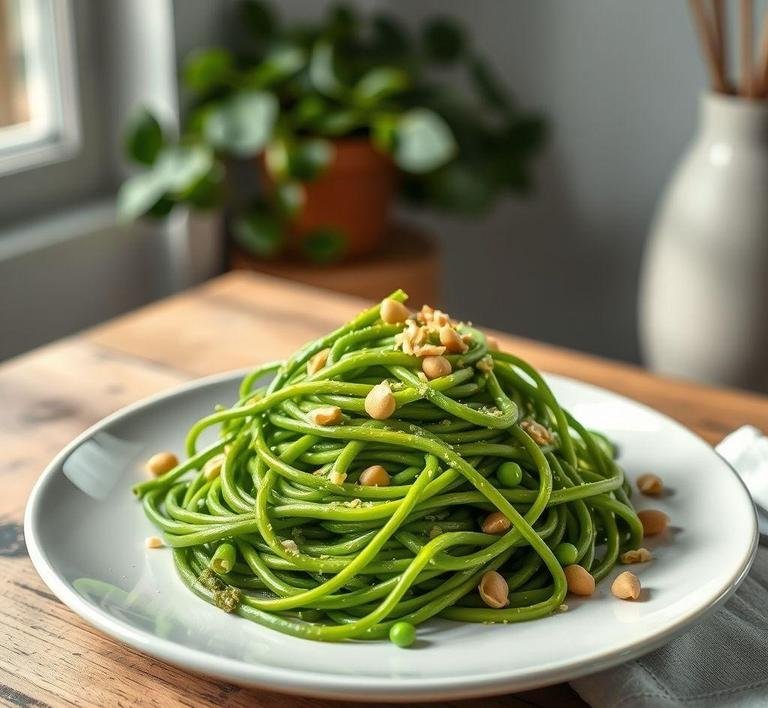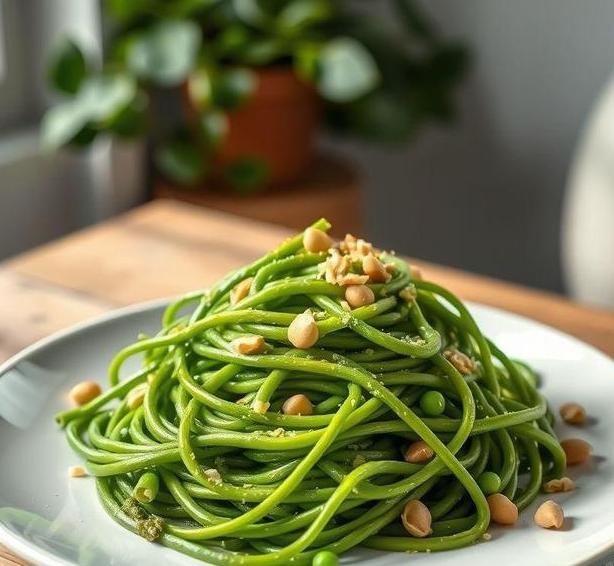Mary Berry’s Pea and Pesto Spaghetti is a simple yet delightful pasta dish that perfectly blends the freshness of peas with the aromatic, herbaceous flavors of pesto. As one of the UK’s most beloved chefs, Mary Berry has earned her reputation for creating recipes that are not only accessible but bursting with flavor. This dish is a great example of her ability to turn everyday ingredients into something both delicious and vibrant. The peas bring a slight sweetness and texture to the spaghetti, while the pesto-typically made from basil, garlic, pine nuts, and Parmesan-adds a rich, herbal depth that ties the dish together beautifully.
Unlike the more complex or cream-heavy pasta dishes, this one is light and refreshing, making it ideal for a summer lunch or a quick dinner on a weeknight. The combination of the fresh peas and the fragrant pesto creates a marriage of flavors that are both comforting and exciting. Whether you’re a novice cook or an experienced home chef, this dish is sure to impress with its ease and elegance.
Mary Berry’s Pea And Pesto Spaghetti Recipe
Ingredients Needed

To create Mary Berry’s Pea and Pesto Spaghetti, you’ll need a few essential ingredients that come together to create a deliciously light but satisfying meal. The ingredients can be easily sourced from your local grocery store, and most of them are kitchen staples. Here’s the list:
- Spaghetti: This long, thin pasta is the perfect base for the dish, absorbing the pesto and complementing the peas without overpowering them.
- Frozen peas: Frozen peas are not only convenient but they also retain their vibrant color and sweet flavor when cooked quickly. You can use fresh peas if available, but frozen peas work beautifully for this recipe.
- Pesto: Mary Berry’s recipe uses a traditional basil pesto, which includes basil, garlic, pine nuts, Parmesan cheese, olive oil, and sometimes lemon juice. You can either make your own pesto or use a store-bought one to save time.
- Parmesan cheese: Freshly grated Parmesan adds a nutty and slightly salty richness to the dish, enhancing the flavor of the pesto and bringing the entire dish together.
- Olive oil: A high-quality extra virgin olive oil is recommended for making pesto as it contributes to the depth of flavor in the sauce.
- Garlic: A few cloves of garlic bring a fragrant, aromatic kick to the pesto.
- Lemon (optional): A touch of lemon zest or juice can brighten up the dish and add a refreshing contrast to the richness of the pesto and pasta.
- Salt and pepper: Basic seasoning to bring out the natural flavors of the peas and pasta.
These ingredients form the foundation of this simple yet tasty dish, with each one contributing something special to the overall flavor profile.
Equipment Needed
The tools required to make this dish are fairly minimal, as it is designed to be quick and easy to prepare. Here’s what you’ll need:
- Large pot: For boiling the spaghetti. You’ll need enough water to comfortably cook the pasta, so a large pot will work best. Don’t forget to salt the water to add flavor to the pasta!
- Colander: To drain the pasta after it’s cooked. This helps remove excess water and keeps the spaghetti from becoming soggy.
- Frying pan: You’ll need a frying pan or a wide sauté pan to combine the cooked peas and pesto. The pan should be large enough to hold the pasta and allow you to toss it easily.
- Ladle or tongs: To transfer the spaghetti from the pot to the frying pan and to mix everything thoroughly without breaking the pasta.
- Grater: For freshly grating the Parmesan cheese over the finished dish. Freshly grated cheese melts better and has a more robust flavor than pre-grated varieties.
- Knife and chopping board: For chopping any garlic or optional herbs or lemon zest.
- Measuring spoons: To ensure you get the right amount of pesto, olive oil, and seasonings.
With these simple tools, you can effortlessly prepare Mary Berry’s Pea and Pesto Spaghetti, bringing the flavors together quickly and efficiently.
Instructions To Make Mary Berry’s Pea And Pesto Spaghetti
Now that you’ve gathered all the ingredients and equipment, here’s a step-by-step guide on how to make Mary Berry’s Pea and Pesto Spaghetti:
- Cook the Spaghetti: Begin by bringing a large pot of salted water to a boil. Once boiling, add the spaghetti and cook according to the package instructions, usually around 8-10 minutes, until al dente. Stir occasionally to prevent the pasta from sticking together.
- Cook the Peas: While the spaghetti is cooking, place the frozen peas in a small saucepan with just enough water to cover them. Bring to a boil and simmer for 2-3 minutes until the peas are tender. Drain the peas and set them aside.
- Prepare the Pesto: If you’re making homemade pesto, combine basil, garlic, pine nuts, Parmesan, and olive oil in a food processor or blender. Blitz until smooth, adding extra olive oil if needed to achieve a silky consistency. Taste and adjust seasoning with salt, pepper, and lemon juice or zest. If you’re using store-bought pesto, skip this step and simply have the jar ready to go.
- Combine Pasta, Peas, and Pesto: Once the spaghetti is cooked and drained, transfer it to a large frying pan over medium heat. Add the peas to the pan with the pasta. Pour in the pesto and toss everything together until the pasta and peas are evenly coated. If needed, add a bit of pasta cooking water to loosen up the pesto.
- Finish the Dish: Taste the pasta and adjust the seasoning if needed with salt, pepper, or a squeeze of fresh lemon juice for added brightness. Serve the pasta with a generous sprinkle of freshly grated Parmesan cheese.
- Garnish and Serve: For an extra touch, you can garnish the dish with a few extra basil leaves or a drizzle of good-quality olive oil before serving. Enjoy the vibrant colors and fresh flavors of your dish!
Tips And Tricks
- Customize the Pesto: While basil pesto is traditional, feel free to get creative with the ingredients. Swap the basil for spinach, arugula, or even mint to create a unique pesto. Adding roasted red peppers or sun-dried tomatoes can also lend an extra depth of flavor.
- Add Protein: If you want to make this dish more filling, you can add cooked chicken, prawns, or even crispy bacon. This can turn the meal into a more substantial dinner.
- Use Fresh Peas: If you can find fresh peas, they’re a great substitute for frozen peas. Just blanch them in boiling water for 2-3 minutes before adding them to the pasta.
- Make it Vegan: If you’re looking for a dairy-free or vegan version of this dish, you can substitute the Parmesan with a plant-based cheese or nutritional yeast. Vegan pesto recipes are also available, using cashews or walnuts in place of pine nuts and leaving out the cheese.
- Storing Leftovers: If you have any leftovers, this pasta will keep well in the fridge for a day or two. Simply reheat it in the microwave or on the stovetop with a splash of water or olive oil to prevent it from drying out.
Mary Berry’s Pea and Pesto Spaghetti is a testament to the power of simple ingredients combined in a thoughtful way. The balance of fresh peas, vibrant pesto, and al dente spaghetti creates a dish that feels both comforting and fresh at the same time. It’s versatile, quick to prepare, and can be customized to suit various dietary preferences or add more protein. Whether you’re cooking for one or serving a crowd, this dish is bound to become a favorite in your repertoire. With just a few ingredients and a bit of time, you can create a meal that’s packed with flavor and sure to please everyone around the table.
Easy Recipe Variations For Mary Berry’s Pea And Pesto Spaghetti

Mary Berry’s Pea and Pesto Spaghetti is a delightful, vibrant dish that’s quick to prepare and bursting with flavor. While the recipe itself is fantastic, there are endless ways to tweak and modify it to suit your tastes or dietary preferences. Here are a few easy variations that will elevate this simple dish into something even more exciting:
- Add Grilled Chicken or Prawns: If you’re craving a bit more protein, adding grilled chicken strips or prawns can make the dish more substantial without overwhelming the delicate flavors of the pesto. Simply season the chicken or prawns with a little salt, pepper, and olive oil, then grill them until golden and juicy. Slice the chicken thinly and scatter it over the top of the pasta just before serving.
- Swap the Pasta: While spaghetti is a classic choice, feel free to experiment with other types of pasta. Fusilli, penne, or even whole wheat spaghetti can be excellent alternatives that offer slightly different textures. For a gluten-free option, use gluten-free pasta made from rice or corn.
- Add Veggies for Extra Flavor: Mary Berry’s original recipe is already packed with peas, but why not throw in a few more vegetables for added color and nutrients? Sauté some spinach, courgettes (zucchini), or bell peppers to mix in with the pasta. Roasted cherry tomatoes add a sweet, juicy burst that perfectly complements the pesto sauce. Even a handful of sautéed mushrooms can bring a savory depth to the dish.
- Make It Vegan: If you prefer a plant-based version, making a few small tweaks can turn this into a completely vegan-friendly meal. Replace the traditional pesto with a dairy-free version made from cashews, nutritional yeast, garlic, lemon, and basil. You can also substitute the regular spaghetti with zucchini noodles (zoodles) or a gluten-free pasta, and add a vegan cheese alternative for extra richness.
- Creamy Pea and Pesto Spaghetti: For a richer, creamier take on the dish, stir in a splash of double cream or a couple of tablespoons of cream cheese into the pesto before tossing with the pasta. This variation gives the dish a comforting, indulgent texture that makes it feel extra luxurious. A drizzle of olive oil just before serving will add a silky finish.
- Lemon Zest & Parmesan Twist: Adding a little lemon zest to the pesto can brighten the flavors and provide a refreshing contrast to the richness of the pesto. A sprinkling of freshly grated Parmesan cheese on top will elevate the dish with its sharp, salty profile. For those who prefer a nutty twist, toasted pine nuts or chopped walnuts make an excellent garnish.
Storing Leftovers
Mary Berry’s Pea and Pesto Spaghetti can be a great make-ahead meal, and if you have any leftovers, it’s easy to store and enjoy the next day. Here are some tips on how to properly store and reheat your leftover pasta:
- Refrigerating Leftovers: After enjoying your meal, if you have leftover spaghetti, allow it to cool completely to room temperature before storing it. Once cooled, place the pasta in an airtight container, ensuring that the pesto coating is evenly distributed across the spaghetti to prevent the pasta from drying out. Store the leftovers in the refrigerator for up to 3-4 days.
- Freezing Leftovers: If you want to keep the dish for a longer period, freezing the pasta is an option, though you may find the texture of the pasta can change slightly upon reheating. To freeze, divide the pasta into individual portions and place each portion in a freezer-safe, airtight container or ziplock bag. It’s best to freeze the pasta without any fresh vegetables or cheese toppings, as these don’t freeze as well. For the best quality, use within 1-2 months.
-
Reheating: When you’re ready to enjoy your leftovers, the best method of reheating depends on how the dish was stored:
- For refrigerated leftovers: Simply warm it up in the microwave, stirring every 30 seconds to ensure even heating. Alternatively, you can reheat the pasta in a pan with a little olive oil or butter over medium heat. If the pasta seems dry, add a splash of water or extra pesto to bring back its creaminess.
- For frozen leftovers: Defrost the pasta in the refrigerator overnight or reheat it from frozen. If using the microwave, heat it in 1-minute intervals, stirring in between to avoid overheating. For stovetop reheating, add a bit of olive oil to a skillet and toss the pasta gently over low heat until heated through.
What To Eat With Mary Berry’s Pea And Pesto Spaghetti?
Mary Berry’s Pea and Pesto Spaghetti is a well-balanced dish that already combines carbohydrates, vegetables, and healthy fats. However, if you’re looking to round out the meal or add a little variety, there are a number of side dishes and accompaniments that can complement it perfectly.
- Side Salad: A light, crisp salad can be the perfect balance to the rich pesto and pasta. Consider a simple green salad with fresh rocket (arugula), mixed greens, or baby spinach, tossed with a light vinaigrette. Add some cucumber, cherry tomatoes, and a few thinly sliced radishes for extra crunch and freshness. A touch of lemon or balsamic vinegar in the dressing will bring a zesty contrast to the creamy pesto.
- Garlic Bread: If you’re in the mood for a comforting addition to your pasta, garlic bread is a classic pairing. You can make your own by spreading garlic butter on slices of baguette or ciabatta and then toasting them in the oven. The crunchy texture of the bread and the aromatic garlic will enhance the flavors of the pasta and pesto.
- Roasted Vegetables: Roasted vegetables like butternut squash, carrots, or aubergine (eggplant) are a fantastic choice to serve alongside the spaghetti. Their natural sweetness and caramelized edges provide a delicious contrast to the vibrant pesto. For a Mediterranean vibe, toss the vegetables in olive oil, rosemary, and thyme before roasting.
- Cheese Platter: If you want something a little more indulgent, a small cheese platter could be a nice touch. Choose cheeses with a variety of textures and flavors like creamy brie, sharp cheddar, or crumbly goat cheese. You can add some olives, nuts, or dried fruits like apricots and figs to give a nice balance of sweet and savory.
- A Glass of White Wine: For a light, refreshing pairing, a crisp white wine such as a Sauvignon Blanc or Pinot Grigio pairs beautifully with the fresh, herby flavors of the pesto. If you prefer something non-alcoholic, a sparkling water with a twist of lemon can provide a refreshing contrast to the rich pasta.
Conclusion
Mary Berry’s Pea and Pesto Spaghetti is an easy, flavorful dish that’s versatile enough to suit any occasion, whether you’re cooking for a busy weeknight dinner or preparing for a more elaborate gathering. With the ability to customize the recipe to your personal preferences-whether you’re adding protein, going vegan, or experimenting with new vegetables-it can be as simple or as indulgent as you like. Pair it with a light side salad, some roasted vegetables, or a slice of garlic bread for the perfect meal. Leftovers can be easily stored and reheated, ensuring you’ll be able to enjoy this delicious dish more than once. Whatever variation or pairing you choose, Mary Berry’s recipe is a comforting, satisfying go-to that can be adapted for any palate.
FAQs
What Ingredients Do I Need For Mary Berry’s Pea And Pesto Spaghetti Recipe?
To make Mary Berry’s Pea and Pesto Spaghetti, you’ll need the following ingredients: spaghetti (or your preferred pasta), frozen peas, fresh basil pesto (either store-bought or homemade), olive oil, garlic, lemon zest, and Parmesan cheese for topping. You may also choose to add extra toppings like pine nuts or cherry tomatoes for added flavor and texture.
Can I Make Mary Berry’s Pea And Pesto Spaghetti Ahead Of Time?
Yes, you can prepare certain components of the dish ahead of time. The pesto can be made in advance and stored in the fridge for up to a week, or even frozen for longer storage. You can also cook the spaghetti and peas earlier in the day and combine them with the pesto when ready to serve. However, it’s best to serve the dish fresh to maintain the vibrant flavors and texture of the pasta.
Can I Make Mary Berry’s Pea And Pesto Spaghetti Vegetarian Or Vegan?
Yes, the dish can be made vegetarian or vegan with a few simple adjustments. To make it vegetarian, simply use a vegetarian pesto that doesn’t contain Parmesan cheese. For a vegan version, opt for a plant-based pesto and substitute the Parmesan with a vegan cheese alternative or nutritional yeast for a cheesy flavor. The rest of the recipe is naturally vegetarian and can be easily adapted for a vegan diet.


